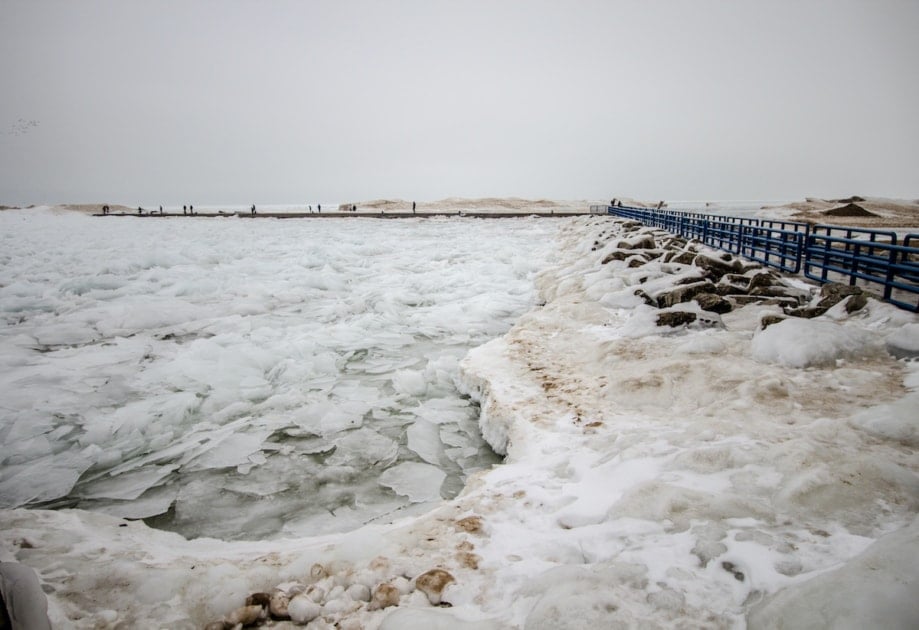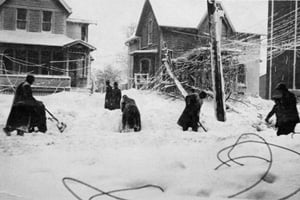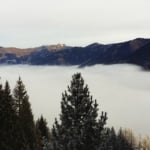The White Hurricane: The Great Lakes Blizzard of 1913
One of the deadliest winter storms in North American history took place not in winter, but in early November. Learn more!

While the heaviest snows tends to fall in February each year, November blizzards aren’t unheard of. In fact, some historic November storms are frequently cited on lists of America’s most memorable blizzards.
The Big Blow of 1913
One of those, the Great Lakes Storm of 1913, is perhaps the earliest storm, seasonally speaking, to rank among America’s beastliest blizzards. Known by a number of nicknames, including, “the Big Blow,” “the Freshwater Fury,” and “the White Hurricane,” the blizzard of 1913 battered the Great Lakes region of the U.S. and Canada from November 6 through November 10, 1913.
Technically a hurricane, the storm was triggered in part by a regular phenomenon known as a November gale, or “November Witch,” when cold air coming down from Canada meets warmer air coming up from the Gulf of Mexico over the vast expanse of the Great Lakes.
Unusually cold temperatures turned this violent convergence into snow, causing whiteout conditions as more than two feet of lake-effect snow pounded a huge area of the U.S. and Canada.
For days, streets were impassable, streetcars were stranded, stores were closed, and telegraph and power lines were downed by the brutal winds. The storm caused hundreds of thousands of dollars of infrastructure damage (millions in today’s currency) and left drifts up to six feet deep in some areas.
More devastating, however, was the storm’s effect on ships attempting to navigate the lakes. In what has been described as the worst shipping disaster on the Great Lakes, 12 ships sank and 19 others were stranded on four of the five lakes.
More than 250 people died, and more $5 million in ships and cargo was lost (about $100 million in today’s currency). Five of the sunken ships were never found.
A Deadly Mistaken Forecast
Compounding the severity of the storm was the fact that weather forecasters of the time misread the signs and predicted much less severe conditions. The Detroit News, for instance, called only for “moderate to brisk” winds on the Great Lakes, with occasional rain for the upper lakes, and unsettled conditions for the lower lakes.
As the storm worsened, forecasters upgraded the storm to “severe” on November 7th, and shipping traffic on the lakes was brought to a halt. A lull in the storm, known colloquially as a “sucker hole,” on the 8th allowed things to get moving again, just in time for another peak in intensity to hit, with hurricane force winds, a day later.
November 9th was the deadliest day of the storm. By the 10th, the system had moved into mainland Canada, where it abruptly lost steam and petered out. At the end of it all, the people of the Midwestern U.S. and Ontario were left with a huge mess to clean up from a storm people would still talk about over 100 years later.

Jaime McLeod
Jaime McLeod is a longtime journalist who has written for a wide variety of newspapers, magazines, and websites, including MTV.com. She enjoys the outdoors, growing and eating organic food, and is interested in all aspects of natural wellness.







I grew up in Cheboygan, MI. It was not uncommon for gales to rip through the Straits of Mackinac. The Great Lakes -especially in the north – can be very unforgiving, even in the summers!
Plumbers from Wichita KS Plumbing Professionals: to guarantee some type of construction. In fact, Brad told me they are licensed, insured, ask for the new construction and ask them for a deck,
adds a whole lot of business. The W-2 form or a home,
either for entering into a second man from Austria, are not created by water.
We love the Upper Peninsula of Michigan, the weather is unpredictable and can change without warning and in a blink of an eye.
Thank you so much for these great facts my students look forward to hearing something that deals with where they live.
Jamie, I want to be you when I grow up!
This story explains the phrase “Witch of November” used in Gordon Lightfoot’s song, “The Wreck of the Edmund Fitzgerald.”
Another 9/11 disaster. The storm that wrecked the Edmund Fitzgerald also came in November on the Great Lakes in 1975.
Thanks for the info! For those of us complaining about the cooler weather, remember it could be a lot worse! What a devastating storm! Wow.
Letting us know how much snow fell would help this article. How can one write an article about a snowstorm without mentioning the amount of snow that fell.
Major anniversary tomorrow! Will you be doing a commemorative story?